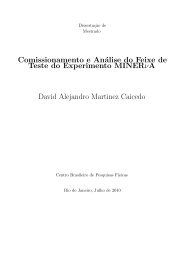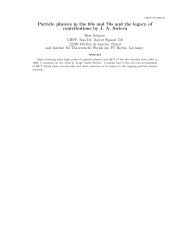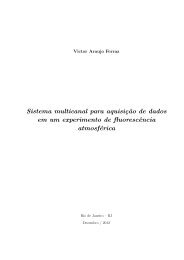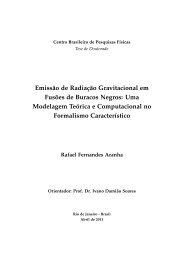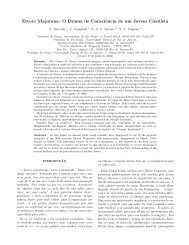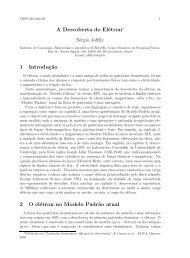Expoente de Lyapunov para um Gás de Lennard–Jones - CBPFIndex
Expoente de Lyapunov para um Gás de Lennard–Jones - CBPFIndex
Expoente de Lyapunov para um Gás de Lennard–Jones - CBPFIndex
You also want an ePaper? Increase the reach of your titles
YUMPU automatically turns print PDFs into web optimized ePapers that Google loves.
Abstract<br />
The largest <strong>Lyapunov</strong> exponent measures the sensitivity to initial conditions in dynamical<br />
systems. Its value provi<strong>de</strong>s the rate of exponential growth of two initially close phase space<br />
trajectories. In contrast with hard-sphere systems, where the theory of <strong>Lyapunov</strong> exponents<br />
is very well known since the Krylov’s work, there is not a consensual approach for smooth<br />
Hamiltonian systems in general. For the latter, usually the answer comes from n<strong>um</strong>erical<br />
simulations, typically using the method <strong>de</strong>veloped by Benettin, which relies on the formal<br />
<strong>de</strong>finition of <strong>Lyapunov</strong> exponent. One attempt to work out this issue was ma<strong>de</strong> with the<br />
so called Stochastic Approach, which offers, in principle, the possibility of obtaining a theo-<br />
retical estimate for the maxim<strong>um</strong> <strong>Lyapunov</strong> exponent of smooth Hamiltonian systems with<br />
many <strong>de</strong>grees of freedom. Based on van Kampen’s c<strong>um</strong>ulant expansion, the Stochastic Ap-<br />
proach expresses the <strong>Lyapunov</strong> exponent as a function of a few statistical properties of the<br />
Hessian matrix of the interaction that can be calculated as suitable microcanonical averages.<br />
We present the application of the Stochastic Approach to a three dimensional N particle<br />
system interacting trough a <strong>Lennard–Jones</strong> 6-12 potential, with fixed temperature, for se-<br />
veral values of <strong>de</strong>nsities. The <strong>para</strong>meters of the theory were calculated both analytically<br />
and n<strong>um</strong>erically, with the n<strong>um</strong>erical studies performed using microcanonical Molecular Dy-<br />
namical simulations. Our final result is the largest <strong>Lyapunov</strong> exponent as function of the<br />
<strong>de</strong>nsity.<br />
Keywords: <strong>Lyapunov</strong> Exponent, Molecular Dynamics, <strong>Lennard–Jones</strong> Potential, C<strong>um</strong>ulant<br />
Expansion.<br />
vii



